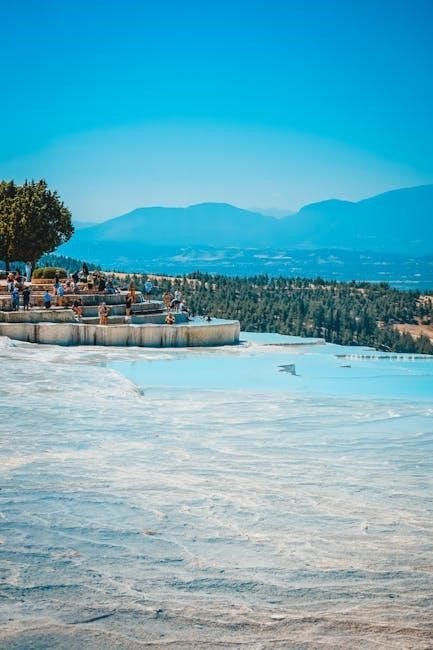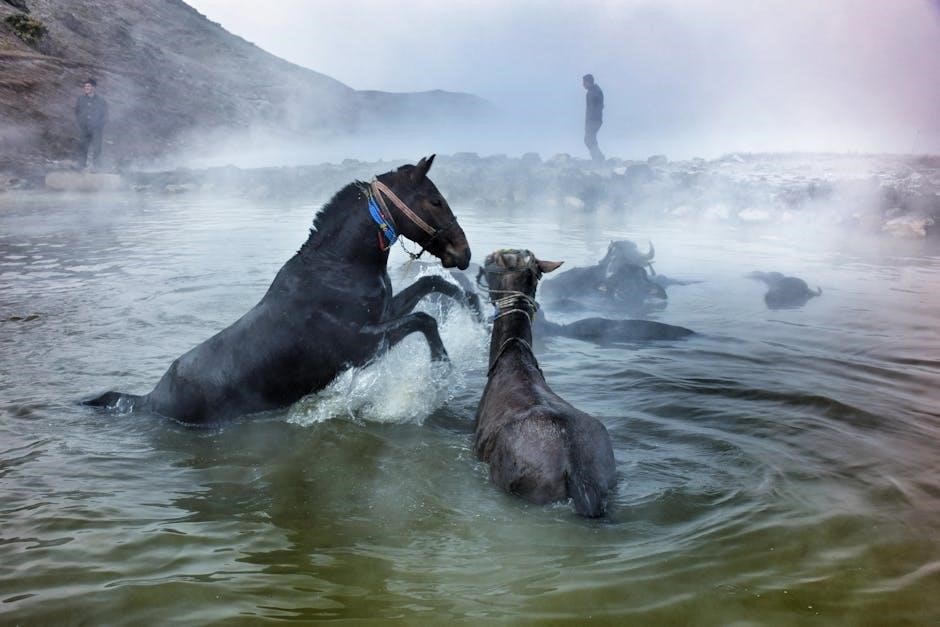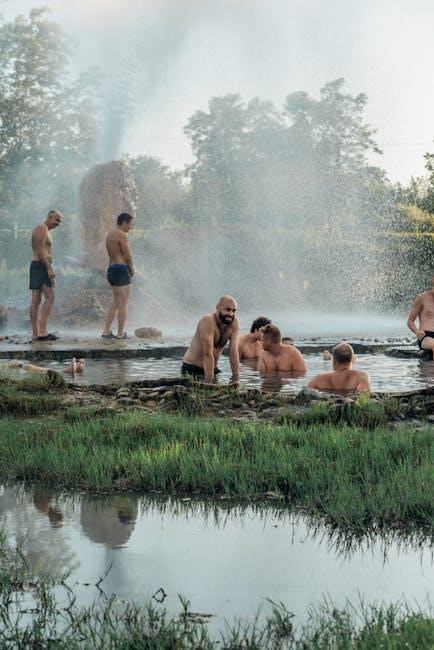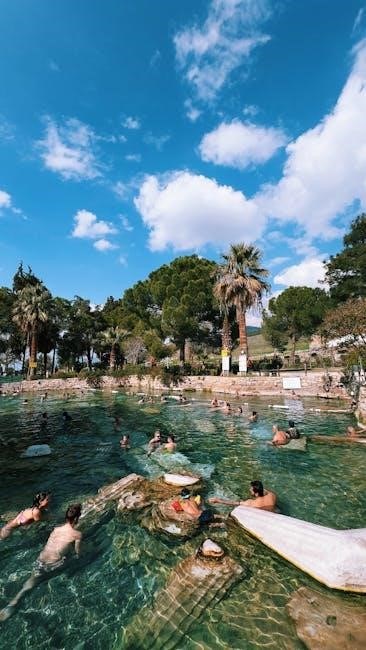Discover the essential guide to troubleshooting your Hot Springs spa, addressing common issues like jet flow, heating, and water quality. Learn maintenance tips and error code solutions to ensure optimal performance and longevity of your spa system. Regular checks and timely fixes will enhance your relaxation experience and prevent major repairs.
Overview of Common Issues in Hot Springs Spas
Hot Springs spas are known for their reliability, but like any complex system, they can experience issues. Common problems include jet and pump malfunctions, heating errors, and water quality concerns. Users may encounter cloudy or dirty water, low jet flow, or overheating. Error codes and display messages often signal specific issues, such as pressure switch problems or electrical faults. Additionally, control panel malfunctions, like unresponsive buttons or blinking lights, can disrupt operation. Addressing these issues promptly is crucial to maintain performance and longevity. Understanding the root causes and implementing routine maintenance can prevent major repairs and ensure a consistent, enjoyable spa experience.
Importance of Regular Maintenance and Troubleshooting
Regular maintenance and troubleshooting are vital for ensuring the optimal performance and longevity of your Hot Springs spa. Proper upkeep prevents issues like clogged jets, heating malfunctions, and water quality problems, which can disrupt your relaxation experience. By addressing problems early, you can avoid costly repairs and extend the lifespan of your spa. Troubleshooting also helps identify worn-out parts that need replacement, ensuring safety and efficiency. A well-maintained spa not only enhances your enjoyment but also maintains hygiene and energy efficiency. Consistent care is an investment in both your spa’s durability and your overall satisfaction.

Common Issues in Hot Springs Spas
Hot Springs spas often face issues such as heating malfunctions, low jet flow, cloudy water, and error codes. These problems can hinder consistent relaxation and require prompt attention.
Heating Problems: Not Heating or Overheating
Heating issues are common in Hot Springs spas, ranging from the system not heating at all to overheating. If your spa isn’t heating, check the power supply, GFCI, and heater elements. Ensure the thermostat is set correctly and not malfunctioning. Overheating can occur due to faulty temperature sensors or a stuck relay. Look for error codes like “OH” (overheat) or “COOL” mode activation. Regular maintenance, such as cleaning filters and inspecting heating elements, can prevent these issues. If problems persist, consult a professional to avoid damage to the system. Addressing heating issues promptly ensures safe and enjoyable use of your spa.
Jets and Pump Issues: Low Flow or No Flow
Low flow or no flow from jets in your Hot Springs spa can disrupt your relaxation experience. Common causes include clogged filters, closed valves, or debris in the plumbing. Start by checking the power supply and ensuring the pump is operational. Inspect the filters and clean or replace them if necessary. Airlocks in the system can also restrict flow; try running the jets on high for a few minutes to clear blockages. If the issue persists, examine the pump for wear or damage. Regular maintenance, such as flushing the system and checking valve alignments, can prevent these problems. Addressing jet and pump issues early ensures consistent performance and extends the lifespan of your spa.

Water Quality Problems: Cloudy or Dirty Water
Cloudy or dirty water in your Hot Springs spa can be caused by poor filtration, improper chemical balance, or contamination. Start by checking the filter—clean or replace it if necessary. Ensure chlorine or bromine levels are within the recommended range, as imbalanced chemicals can lead to cloudy water. Shocking the spa after heavy use or contamination can help restore clarity. Regularly test and adjust pH and alkalinity levels to prevent scaling and maintain clean water. If the issue persists, consider draining and refilling the spa with fresh water. Proper sanitization and routine maintenance are key to keeping your spa water clean and safe for use.

Understanding Error Codes and Display Messages
Learn to interpret error codes and display messages on your Hot Springs spa, which indicate issues like temperature faults or pressure problems, guiding DIY troubleshooting solutions effectively.
Common Error Codes and Their Meanings
Hot Springs spas often display error codes like “E1” or “PS” to indicate specific issues. These codes can signal problems such as temperature faults, pressure sensor malfunctions, or flow restrictions. For example, a “FLO” error typically points to low water flow, which could be due to clogged filters or closed valves. Understanding these codes is crucial for quick troubleshooting. Always refer to your spa’s manual or online resources for precise code meanings, as they may vary slightly by model. Addressing these issues promptly can prevent further damage and ensure your spa operates smoothly. Regular maintenance, like cleaning filters, can help avoid many of these errors altogether.
How to Reset Your Hot Springs Spa System
To reset your Hot Springs spa system, start by pressing the reset button on the GFCI protector, usually located near the spa’s electrical connection. Once reset, enter the code “3-1-2-3” on the control panel to restore default settings. Turn on the jets for about 30 seconds to allow the system to recalibrate. This process can resolve issues like error messages or unresponsiveness. If the problem persists, consult your owner’s manual or contact a professional. Regular resets can help maintain optimal performance and prevent major malfunctions. Always ensure the spa is powered off before attempting any electrical adjustments.

Electrical and Control Panel Troubleshooting
Check power sources, circuit breakers, and GFCI outlets; Ensure connections are secure and avoid water exposure. Test buttons and lights for responsiveness. Reset the system if needed.
Power Issues: Spa Not Turning On
If your Hot Springs spa isn’t turning on, start by checking the GFCI outlet or circuit breaker to ensure power is available. Verify that all connections are secure and free from water exposure. Ensure the main power supply is on and the spa is properly plugged in. If the issue persists, inspect the control panel for any tripped switches or blown fuses. Resetting the system by turning the power off and on again may resolve the problem. Always consult the owner’s manual for specific instructions, and if issues remain, contact a professional technician to diagnose and repair electrical faults.
Control Panel Malfunctions: Blinking Lights or Unresponsive Buttons
If your Hot Springs spa’s control panel is malfunctioning, check for blinking lights or unresponsive buttons, which often indicate specific issues. Start by ensuring the power supply is stable and the GFCI hasn’t tripped. Reset the system by turning the power off and on again. If the issue persists, consult the error code chart in your manual to identify the problem. Clean the control panel to remove dirt or moisture that may interfere with button functionality. For persistent malfunctions, contact a certified technician to diagnose and repair faulty sensors, wiring, or faulty control panel components. Regular maintenance can prevent such issues and ensure smooth operation.

Advanced Troubleshooting Techniques
Explore advanced diagnostic methods for complex spa issues, including system recalibration, sensor testing, and specialized tool usage to identify and resolve deep-rooted malfunctions effectively.
Identifying and Fixing Leaks in the Spa System
Leaks in a Hot Springs spa can lead to significant water loss and system damage. To identify leaks, inspect the spa’s plumbing, jets, and connections for water droplets or puddles. Turn off the power and drain the spa partially for a closer examination. Food coloring can be added to the water to trace the source of the leak. Once located, turn off the power and apply a sealant or replace worn gaskets. For major leaks, professional assistance may be needed. Regular maintenance, such as inspecting O-rings and hoses, can prevent leaks. Addressing leaks promptly ensures optimal performance and longevity of your spa system.
Troubleshooting the Spa’s Filtration System
Troubleshooting the filtration system in your Hot Springs spa is essential for maintaining clean, safe water. Common issues include poor water quality, low flow rates, or the filter not cycling properly. Start by inspecting the filter for dirt or damage—clean or replace it as needed. Check the filter cycle settings to ensure it runs long enough daily; If the system still underperforms, examine the pump and plumbing for blockages or kinks. Regularly sanitizing the spa and balancing chemicals can also prevent filtration problems. For persistent issues, consult the owner’s manual or contact a professional to ensure your spa’s filtration system operates efficiently and effectively.

Preventative Maintenance Tips

Regular maintenance is crucial for your spa’s longevity. Clean filters, balance chemicals, and inspect components regularly to prevent issues. Sanitize surfaces and maintain proper water circulation for optimal performance.
Regular Cleaning and Sanitizing of the Spa
Regular cleaning and sanitizing are vital for maintaining your Hot Springs spa’s hygiene and performance. Start by cleaning the filter regularly to ensure proper water circulation and filtration. Wipe down the spa surfaces with a mild detergent to remove dirt and oils. Sanitize the water using recommended chemicals, such as chlorine or bromine, to maintain safe bacteria levels. Perform a deep clean of the spa shell and jets every few months to remove built-up debris. Always follow the manufacturer’s guidelines for cleaning products and sanitizing levels to ensure a safe and enjoyable experience. Consistency is key to preventing maintenance issues.
Inspecting and Replacing Worn-Out Parts
Regularly inspecting and replacing worn-out parts is crucial for maintaining your Hot Springs spa’s efficiency and longevity. Check the jets, pumps, and seals for signs of wear or damage, as these components are prone to degradation over time. Replace any cracked or corroded parts immediately to prevent leaks or system failures. Ensure all replacements are genuine and compatible with your spa model. Additionally, inspect the filter and other accessories for dirt buildup or damage. Addressing these issues promptly can prevent costly repairs and ensure optimal performance. Always refer to your owner’s manual for specific guidance on part replacement and maintenance schedules.

Effective troubleshooting and regular maintenance are key to extending your Hot Springs spa’s lifespan and ensuring reliable performance. By addressing issues promptly, you can enjoy a relaxing, hassle-free experience.
Final Thoughts on Effective Troubleshooting
Effective troubleshooting begins with proactive maintenance and understanding common issues like error codes, heating problems, and water quality. Regularly cleaning filters, inspecting pumps, and addressing electrical issues can prevent major breakdowns. Familiarizing yourself with your spa’s user manual and troubleshooting guides ensures timely fixes. By staying vigilant and addressing problems early, you can extend the lifespan of your Hot Springs spa and maintain its optimal performance. Remember, consistent care and quick action are key to enjoying a relaxing and hassle-free spa experience year-round.
Recommended Resources for Further Assistance
For comprehensive support, refer to the official Hot Springs Spa Owner’s Manual, which provides detailed troubleshooting guides and maintenance tips. Additionally, visit the Hot Springs Spas official website for downloadable resources, including repair manuals and FAQs. Engage with online forums like Hot Tub Forums or Spa Tech to connect with experts and users who share solutions. YouTube channels like Hot Tub Repair offer step-by-step video tutorials. If issues persist, contact Hot Springs Spas Customer Support directly for personalized assistance. Lastly, consult certified technicians for complex problems to ensure your spa operates efficiently and safely.